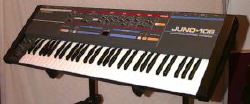 |
Roland Instruments
Alpha-Juno 1
Alpha-Juno 2
Boss DR-55
Boss DR-110
Boss DR-660
CM-32L
CMU-800 CompuMusic
CMU-810
CR-68
CR-78
CSQ-100
CSQ-600
D-5
D-10
D-20
D-50
D-110
E-20
EM-101
GR-300
HS-10
JSQ Sequencers
Juno-6
Juno-60
Juno 106
Jupiter-4
Jupiter-6
Jupiter-8
JX-3P
JX-8P
JX-10 (Super JX)
MC-4
MC-8
MC-202 MicroComposer
MKS-7 Super Quartet
MKS-10 Planet-P
MKS-30 Planet-S
MKS-50
MKS-70 Super JX
MKS-80 Super Jupiter
MKS-100
MSQ-100 Sequencer
MSQ-700 Sequencer
MT-32
PG-200
PG-300
PG-800
Pro-Mars (MRS-2)
RS-09
RS-101
RS-202
RS-505 Paraphonic
S-5
S-10
S-330
S-550
Saturn 09 (SA-09)
SH-1
SH-2
SH-3
SH-5
SH-7
SH-09
SH-101
SH-1000
SH-2000
SPV-355
System 100
System 100m
System 700
TR-66
TB-303
TR-505
TR-606
TR-626
TR-707
TR-727
TR-808
TR-909
U-110
VP-330 Vocoder Plus
|
 |
 |
Juno-106

above photo from the collection of Joseph Rivers, Audio Playground, Orlando, FL
other synths in the Audio Playground Collection
Roland Juno-106 is an analog synth with DCOs (digitally controlled oscillators), and a 61-note, 5-octave (C-C) keyboard (no aftertouch or velocity). In 1984, when it was introduced, it had the most complete MIDI implementation of any synthesizer on the market. All of its front panel faders also send MIDI sys-ex data which can be sequenced. Its sound is nice and full even though it has DCOs (which are generally not as warm as VCOs). The Juno-106 features 6-voice polyphony, each voice having its own VCF. For each patch, the DCO waveform can be set to Pulse (with a variable pulse width), Triangle, and Sawtooth, with sliders controlling the level of the noise generator and the sub-harmonic oscillator. There is a High Pass Filter with 4 control positions, as well as a VCF (low pass) with resonance and controls for envelope, keyboard, and LFO modulation. The Juno-106 has 1 ADSR envelope where each stage is controlled by a separate slider, and a triangle wave LFO that has controls for rate and delay. It also features a stereo chorus which can be set to "Rich," "Harmonic," or Off.
One of the best things the Juno-106 has going for it is its front panel. Being one of the last synthesizers to have sliders or knobs on its front panel, it is one of the simplest and intuitive synths to program. This makes it a great choice for first time synth programmers.

Who Played This Instrument?
808 State,
Alien Sex Fiend,
Apollo 440,
Art of Trance,
Autechre,
Bass-O-Matic,
Beautiful People,
Big Beat Combo,
Bioshpere,
Blame - England's sidekick to ltj bukem,
Paul Bliss,
Brothers in Rhythm,
David Bryan,
Burn Cycle Rv. 2,
Cabaret Voltaire,
Danny Chang,
Chemical Brothers,
The Christians,
Dave Clayton,
Crystal Method,
Daft Punk,
D.A.V.E.,
DDR,
Depeche Mode,
DNA,
D.Ream,
The Drummer,
Dr. Nner,
Dune,
E.Naive,
Eat Static,
Electronic,
Electronic Dream Planet,
EMF,
Eskimos & Egypt,
Extra Extra,
Fatboy Slim,
Frank Chickens,
Frankie Goes To Hollywood,
Pascal Gabriel of S'Express,
Laurent Garnier,
Philip Glass Ensemble,
Global Communications,
The Grid,
Human League,
Rob Hyman of Hooters,
Incognito,
Inner City,
Infected Mushroom,
It BItes,
Izit,
Jean-Michel Jarre,
Jesus Jones,
Joy Electric,
Nabil Hawa,
Kenny Larkin,
Leftfield,
Sean Lennon,
David Lewis,
Chris Liberator,
Locust,
Willard E. Love,
Guy McAffer,
Man Machine,
Mansun,
Men's Recovery Project - album "Frank Talk About Humans",
George Michael,
Moby,
Motiv8,
Chris Newman,
Pulp,
William Orbit,
The Other Two,
Oznic Tentacles,
Mauricio Paredes,
Pet Shop Boys - for song "very",
Rob Playford,
Andrew Poppy,
The Prodigy,
Q,
Reel 2 Reel,
Rowland The Bastard,
Sabres of Paradise,
Riuichi Sakamoto,
Kevin Saunderson,
Patrick Seymour of Eurthymics,
Shamen,
Mark Shreeve,
Tim Simenon of Bomb the Bass,
Soul Oddity,
Sub Sub,
Mick Talbot of Style Council,
Tangerine Dream,
Terra Ferma,
David Toop,
Mark Tyler,
Underworld,
Union Jack,
Vangelis,
Youth
[Let us know if you have any further additions to this list.]
|

